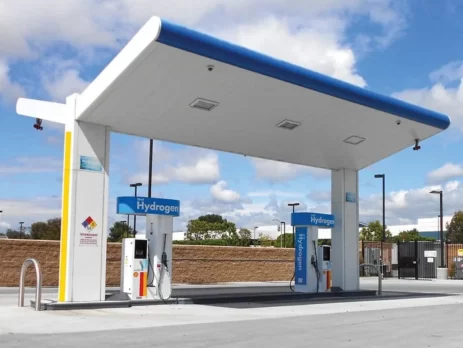Safety On Hydrogen Refuelling Stations
Hydrogen refuelling stations (HRS) are static systems and the leak points for hydrogen are most likely to be valves, connectors, and the flexible hoses. It is advisable to use fixed gas or flame detection equipment sited close to these locations.
Public HRS stations are likely to be in the open air to enable the free movement of vehicles. In these cases, the natural wind may blow a hydrogen leak in one direction or another. Therefore, multiple gas detectors may be required to ensure the leak is sensed whatever the wind conditions. For indoor bus depots or hydrogen refuelling of indoor forklift truck fleets, variable wind direction is less likely to be a factor that must be addressed.
Flame detection can be used as a second line of defence, in combination with gas detectors. Using multiple gas detection devices and flame detectors, the operator can use a ‘voting system’ to escalate the system response from a visual alarm to an audible alarm and ultimately to an automated system shutdown, according to the number of gas and flame detectors that have been activated. This can help to minimise disruptive ‘false-alarms’ and simultaneously ensures that a truly hazardous situation is flagged as quickly as possible.
High pressure is unavoidable on the HRS
On a hydrogen refuelling station (HRS) there generally be an inventory of hydrogen at high pressure. Even if there is on-site hydrogen production using an electrolyser, storage of hydrogen is required to ensure that there is sufficient gas available to fill the tank of an incoming vehicle rapidly.
The buffer storage of hydrogen must be at high pressure. The reason is that there needs to be a driving pressure from the storage to the bus. When the bus tank is ‘full’ it will be at 350 bar. The pressure in the storage will need to be a minimum of 400 bar to ensure a 50 bar pressure gradient to transfer the hydrogen into the bus rapidly. In essence, the static storage on the HRS is ‘empty’ at 400 bar.
High pressure is itself a hazard. Additionally, the higher the pressure of the gas, the more hydrogen inventory exists. Since a moderate inventory of high-pressure hydrogen is an operational requirement of the HRS, the focus must be placed on mitigating the risk in ways other than reducing the pressure or inventory.
Engineering design may specify gas and flame detection
Appropriate engineering and design of hydrogen systems requires the use of established safety processes such as Layers of Protection Analysis (LOPA), Hazard Analysis (HAZAN), Risk Assessment (RA), and Hazard and Operability Study (HAZOP). Using these tools will call for the implementation of appropriate mitigating actions.
Many of the actions that result from these studies will be focused on avoiding leaks of hydrogen. To add to the layers of protection, gas and flame detection are also often specified. These safety devices cannot avoid leaks, but they can reduce the severity of a leak and thereby reduce the size of the hazard.
Gas detection, for example, can shut off a valve to prevent a small leak developing into a larger one. For some gas alarms a simple response such as closing an actuated valve may be suitable to eliminate the hazard. Or a full emergency shut down of the process and evacuation may be required if the combination of alarms indicates an extremely hazardous situation.
Doubling up with dis-similar sensors improves system integrity
Electrochemical and catalytic sensors can be used for hydrogen gas detection. For maximum safety, it is recommended to use two different technologies to detect any type of gas, and the same applies to hydrogen.
The benefit of doubling up detection with dis-similar technolgies is stonger than duplicating the same technology. This is because there may be adverse environmental conditions which impact one of the two gas sensor technologies, but the other type of sensor may continue to function normally.
